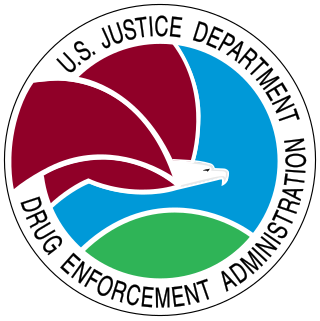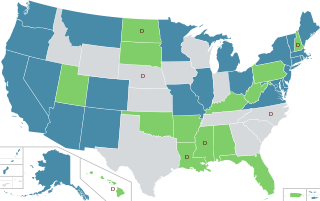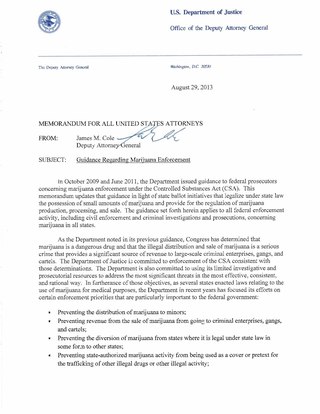
The Drug Enforcement Administration (DEA) is a United States federal law enforcement agency under the U.S. Department of Justice tasked with combating illicit drug trafficking and distribution within the U.S. It is the lead agency for domestic enforcement of the Controlled Substances Act, sharing concurrent jurisdiction with the Federal Bureau of Investigation, the U.S. Immigration and Customs Enforcement, and U.S. Customs and Border Protection. However, the DEA has sole responsibility for coordinating and pursuing U.S. drug investigations both domestically and internationally.

Proposition 215, or the Compassionate Use Act of 1996, is a California law permitting the use of medical cannabis despite marijuana's lack of the normal Food and Drug Administration testing for safety and efficacy. It was enacted, on November 5, 1996, by means of the initiative process, and passed with 5,382,915 (55.6%) votes in favor and 4,301,960 (44.4%) against.

The Campaign Against Marijuana Planting (CAMP) is a multi-agency law enforcement task force managed by the California Department of Justice and composed of local, state and federal agencies organized expressly to eradicate illegal cannabis cultivation and trafficking in California. Since its establishment in 1983, more than 110 agencies having participated, making CAMP one of the largest law enforcement task force in the United States.

In the United States, the non-medical use of cannabis is legalized in 24 states and decriminalized in 7 states, as of November 2023. Decriminalization refers to a policy of reduced penalties for cannabis offenses, typically involving a civil penalty for possessing small amounts, instead of criminal prosecution or the threat of arrest. In jurisdictions without penalty the policy is referred to as legalization, although the term decriminalization is sometimes used for this purpose as well.

In the United States, increased restrictions and labeling of cannabis as a poison began in many states from 1906 onward, and outright prohibitions began in the 1920s. By the mid-1930s cannabis was regulated as a drug in every state, including 35 states that adopted the Uniform State Narcotic Drug Act. The first national regulation was the Marihuana Tax Act of 1937.

The use, sale, and possession of cannabis containing over 0.3% THC by dry weight in the United States, despite laws in many states permitting it under various circumstances, is illegal under federal law. As a Schedule I drug under the federal Controlled Substances Act (CSA) of 1970, cannabis containing over 0.3% THC by dry weight is considered to have "no accepted medical use" and a high potential for abuse and physical or psychological dependence. Cannabis use is illegal for any reason, with the exception of FDA-approved research programs. However, individual states have enacted legislation permitting exemptions for various uses, including medical, industrial, and recreational use.

Cannabis in Oregon is legal for both medical and recreational use. In recent decades, the U.S. state of Oregon has had a number of legislative, legal, and cultural events surrounding use of cannabis. Oregon was the first state to decriminalize the possession of small amounts of cannabis, and among the first to authorize its use for medical purposes. An attempt to recriminalize possession of small amounts of cannabis was turned down by Oregon voters in 1997.
Operation Green Sweep was a series of drug raids conducted by over 200 United States Army soldiers, National Guardsmen, and federal agents in Humboldt County, California. The operation was the first time active-duty troops were used to combat marijuana growing in the United States. The joint federal and state operation led by the Bureau of Land Management was centered around eradicating marijuana and removing agribusiness paraphernalia from the King Range National Conservation Area, federal land administered by BLM near Petrolia, California.
The "Cornbread mafia" was the name for a group of Kentucky men who created the largest domestic marijuana production operation in United States history. It was based in Marion, Nelson and Washington counties in central Kentucky. The term "Cornbread Mafia" was first used in public by federal prosecutors in a June 1989 press conference, where they revealed that 70 men had been arrested for organizing a marijuana trafficking ring that stretched across 30 farms in 10 states stretching from the Southeast into the Midwest. The story was first reported in the Courier Journal Magazine in Louisville, Kentucky on October 8, 1989, and then in 2012 in the narrative non-fiction book The Cornbread Mafia: A Homegrown Syndicate's Code Of Silence And The Biggest Marijuana Bust In American History (2012), by James Higdon.

California Proposition 19 was a ballot initiative on the November 2, 2010, statewide ballot. It was defeated, with 53.5% of California voters voting "No" and 46.5% voting "Yes." If passed, it would have legalized various marijuana-related activities, allowed local governments to regulate these activities, permitted local governments to impose and collect marijuana-related fees and taxes, and authorized various criminal and civil penalties. In March 2010, it qualified to be on the November statewide ballot. The proposition required a simple majority in order to pass, and would have taken effect the day after the election. Yes on 19 was the official advocacy group for the initiative and California Public Safety Institute: No On Proposition 19 was the official opposition group.

Colorado Amendment 64 was a successful popular initiative ballot measure to amend the Constitution of the State of Colorado, outlining a statewide drug policy for cannabis. The measure passed on November 6, 2012, and along with a similar measure in Washington state, marked "an electoral first not only for America but for the world."

The legal history of cannabis in the United States began with state-level prohibition in the early 20th century, with the first major federal limitations occurring in 1937. Starting with Oregon in 1973, individual states began to liberalize cannabis laws through decriminalization. In 1996, California became the first state to legalize medical cannabis, sparking a trend that spread to a majority of states by 2016. In 2012, Washington and Colorado became the first states to legalize cannabis for recreational use.

The recreational and medicinal use of cannabis in the Northern Mariana Islands has been legal since September 2018. House Bill 20-178 was signed into law by Gov. Ralph Torres, becoming Public Law 20-66. The cannabis legalization bill was introduced as the "Taulamwaar Sensible CNMI Cannabis Act of 2018," named in honor of David Kapileo Peter or Taulamwaar, who advocated cannabis legalization over four years ago. The first dispensary opened to the public on July 16, 2021.
Cannabis in Nebraska is fully illegal, but first offense for possession of small amounts was reduced to a civil infraction in 1979.

The Cole Memorandum was a United States Department of Justice memorandum issued August 29, 2013, by United States Deputy Attorney General James M. Cole during the presidency of Barack Obama. The memorandum, sent to all United States Attorneys, governed federal prosecution of offenses related to marijuana. The memo stated that given its limited resources, the Justice Department would not enforce federal marijuana prohibition in states that "enacted laws legalizing marijuana in some form and ... implemented strong and effective regulatory and enforcement systems to control the cultivation, distribution, sale, and possession of marijuana," except where a lack of federal enforcement would undermine federal priorities.
The Domestic Cannabis Eradication/Suppression Program is a Drug Enforcement Administration-funded program to eradicate cannabis in the United States. DEA began the program in 1979 during the War on Drugs. In the first few years of the Reagan administration, the program expanded from seven states to forty. By 1985 it was active in all fifty states.
The cannabis policy of the Reagan administration involved affirmation of the War on Drugs, government funded anti-cannabis media campaigns, expanded funding for law enforcement, involvement of the U.S. military in interdiction and eradication, reduction in emphasis in drug treatment, and creation of new Federal powers to test employees and seize cannabis-related assets.
The Tennessee Governor's Task Force on Marijuana Eradication (GTFME), a multi-agency law enforcement task force founded in 1983, is managed by the Office of the Governor of Tennessee composed of local, state agencies organized expressly to eradicate illegal cannabis cultivation and trafficking in Tennessee. The Governor's Task Force is operated by the Tennessee Bureau of Investigation's Tennessee Dangerous Drugs Task Force. The eradication season lasts from May through September in Tennessee, where outdoor marijuana cultivation ranks second in the United States, behind California. The task force, divided into three regional teams, East, Middle and West, centralized marijuana eradication in the state into a coordinated multi-agency program.
Florida's Domestic Marijuana Eradication Program, is a multi-agency state and federal law enforcement program founded in 1981, jointly managed by the Drug Enforcement Administration and the Florida Department of Agriculture and Consumer Services to provide funding for local law enforcement agencies’ efforts to eradicate illegal cannabis cultivation and trafficking in Florida.








